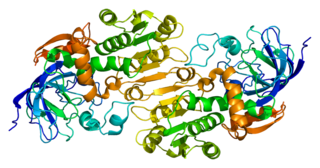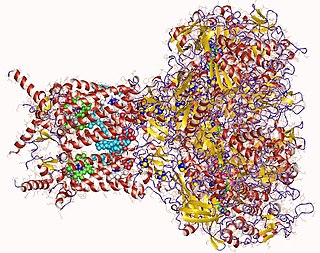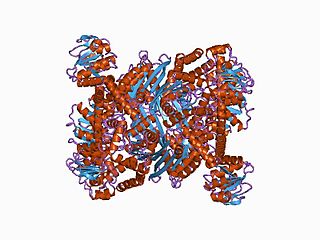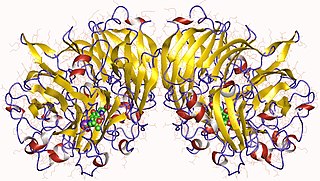A dehydrogenase is an enzyme belonging to the group of oxidoreductases that oxidizes a substrate by reducing an electron acceptor, usually NAD+/NADP+ or a flavin coenzyme such as FAD or FMN. Like all catalysts, they catalyze reverse as well as forward reactions, and in some cases this has physiological significance: for example, alcohol dehydrogenase catalyzes the oxidation of ethanol to acetaldehyde in animals, but in yeast it catalyzes the production of ethanol from acetaldehyde.

Alcohol dehydrogenases (ADH) (EC 1.1.1.1) are a group of dehydrogenase enzymes that occur in many organisms and facilitate the interconversion between alcohols and aldehydes or ketones with the reduction of nicotinamide adenine dinucleotide (NAD+) to NADH. In humans and many other animals, they serve to break down alcohols that are otherwise toxic, and they also participate in the generation of useful aldehyde, ketone, or alcohol groups during the biosynthesis of various metabolites. In yeast, plants, and many bacteria, some alcohol dehydrogenases catalyze the opposite reaction as part of fermentation to ensure a constant supply of NAD+.

Nicotinamide adenine dinucleotide (NAD) is a coenzyme central to metabolism. Found in all living cells, NAD is called a dinucleotide because it consists of two nucleotides joined through their phosphate groups. One nucleotide contains an adenine nucleobase and the other, nicotinamide. NAD exists in two forms: an oxidized and reduced form, abbreviated as NAD+ and NADH (H for hydrogen), respectively.

Pyrroloquinoline quinone (PQQ), also called methoxatin, is a redox cofactor and antioxidant.

Nicotinamide adenine dinucleotide phosphate, abbreviated NADP+ or, in older notation, TPN (triphosphopyridine nucleotide), is a cofactor used in anabolic reactions, such as the Calvin cycle and lipid and nucleic acid syntheses, which require NADPH as a reducing agent ('hydrogen source'). NADPH is the reduced form, whereas NADP+ is the oxidized form. NADP+ is used by all forms of cellular life.
Methylotrophs are a diverse group of microorganisms that can use reduced one-carbon compounds, such as methanol or methane, as the carbon source for their growth; and multi-carbon compounds that contain no carbon-carbon bonds, such as dimethyl ether and dimethylamine. This group of microorganisms also includes those capable of assimilating reduced one-carbon compounds by way of carbon dioxide using the ribulose bisphosphate pathway. These organisms should not be confused with methanogens which on the contrary produce methane as a by-product from various one-carbon compounds such as carbon dioxide. Some methylotrophs can degrade the greenhouse gas methane, and in this case they are called methanotrophs. The abundance, purity, and low price of methanol compared to commonly used sugars make methylotrophs competent organisms for production of amino acids, vitamins, recombinant proteins, single-cell proteins, co-enzymes and cytochromes.
Pink-Pigmented Facultative Methylotrophs, commonly abbreviated to PPFMs, are bacteria that are members of the genus Methylobacterium and are commonly found in soil, dust, various fresh water supplies and on plant surfaces. Although Gram negative, Methylobacteria often stain gram variable and are easily isolated using methanol-based mineral medium. Their pigmentation, which is frequently pink but may also be yellow or orange, is thought to provide protection from solar UV radiation which damages the DNA of bacteria at low doses because of their small cell size. This color is present due to the carotenoid pigments within the cell.
Methylorubrum extorquens is a Gram-negative bacterium. Methylorubrum species often appear pink, and are classified as pink-pigmented facultative methylotrophs, or PPFMs. The wild type has been known to use both methane and multiple carbon compounds as energy sources. Specifically, M. extorquens has been observed to use primarily methanol and C1 compounds as substrates in their energy cycles. It has been also observed that use lanthanides as a cofactor to increase its methanol dehydrogenase activity
Methylobacillus flagellatus is a species of aerobic bacteria.

Formate dehydrogenases are a set of enzymes that catalyse the oxidation of formate to carbon dioxide, donating the electrons to a second substrate, such as NAD+ in formate:NAD+ oxidoreductase (EC 1.17.1.9) or to a cytochrome in formate:ferricytochrome-b1 oxidoreductase (EC 1.2.2.1). This family of enzymes has attracted attention as inspiration or guidance on methods for the carbon dioxide fixation, relevant to global warming.

In enzymology, a malate dehydrogenase (NADP+) (EC 1.1.1.82) is an enzyme that catalyzes the chemical reaction
In enzymology, an alcohol dehydrogenase (acceptor) (EC 1.1.99.8) is an enzyme that catalyzes the chemical reaction
Alanine dehydrogenase (EC 1.4.1.1) is an enzyme that catalyzes the chemical reaction

In molecular biology, the ELFV dehydrogenase family of enzymes include glutamate, leucine, phenylalanine and valine dehydrogenases. These enzymes are structurally and functionally related. They contain a Gly-rich region containing a conserved Lys residue, which has been implicated in the catalytic activity, in each case a reversible oxidative deamination reaction.

Methanol dehydrogenase (cytochrome c) (EC 1.1.2.7, methanol dehydrogenase, MDH) is an enzyme with systematic name methanol:cytochrome c oxidoreductase. This enzyme catalyses the following chemical reaction
Alcohol dehydrogenase (quinone) (EC 1.1.5.5, type III ADH, membrane associated quinohaemoprotein alcohol dehydrogenase) is an enzyme with systematic name alcohol:quinone oxidoreductase. This enzyme catalyses the following chemical reaction
Methanol dehydrogenase (nicotinoprotein) (EC 1.1.99.37, NDMA-dependent methanol dehydrogenase, nicotinoprotein methanol dehydrogenase, methanol:N,N-dimethyl-4-nitrosoaniline oxidoreductase) is an enzyme with systematic name methanol:acceptor oxidoreductase. This enzyme catalyses the following chemical reaction
Mycofactocin (MFT) is a family of small molecules derived from a peptide of the type known as RiPP (ribosomally synthesized and post-translationally modified peptides), naturally occurring in many types of Mycobacterium. It was discovered in a bioinformatics study in 2011. All mycofactocins share a precursor in the form of premycofactocin (PMFT); they differ by the cellulose tail added. Being redox active, both PMFT and MFT have an oxidized dione (mycofactocinone) form and a reduced diol (mycofactocinol) form, respectively termed PMFTH2 and MFTH2.
Methylophaga thiooxydans is a methylotrophic bacterium that requires high salt concentrations for growth. It was originally isolated from a culture of the algae Emiliania huxleyi, where it grows by breaking down dimethylsulfoniopropionate from E. hexleyi into dimethylsulfide and acrylate. M. thiooxydans has been implicated as a dominant organism in phytoplankton blooms, where it consumes dimethylsulfide, methanol and methyl bromide released by dying phytoplankton. It was also identified as one of the dominant organisms present in the plume following the Deepwater Horizon oil spill, and was identified as a major player in the breakdown of methanol in coastal surface water in the English channel.
Bacillus methanolicus is a gram positive, thermophilic, methylotrophic member of the genus Bacillus. The most well characterized strain of the species, Bacillus methanolicus MGA3, was isolated from freshwater marsh soils, and grows rapidly in cultures heated to up to 60 °C using only methanol as a carbon source. The genome of B. methanolicus MGA3 was fully sequenced in 2014, revealing a 3,337,035 bp linear chromosome and two natural plasmids, pBM19 and pBM69.










